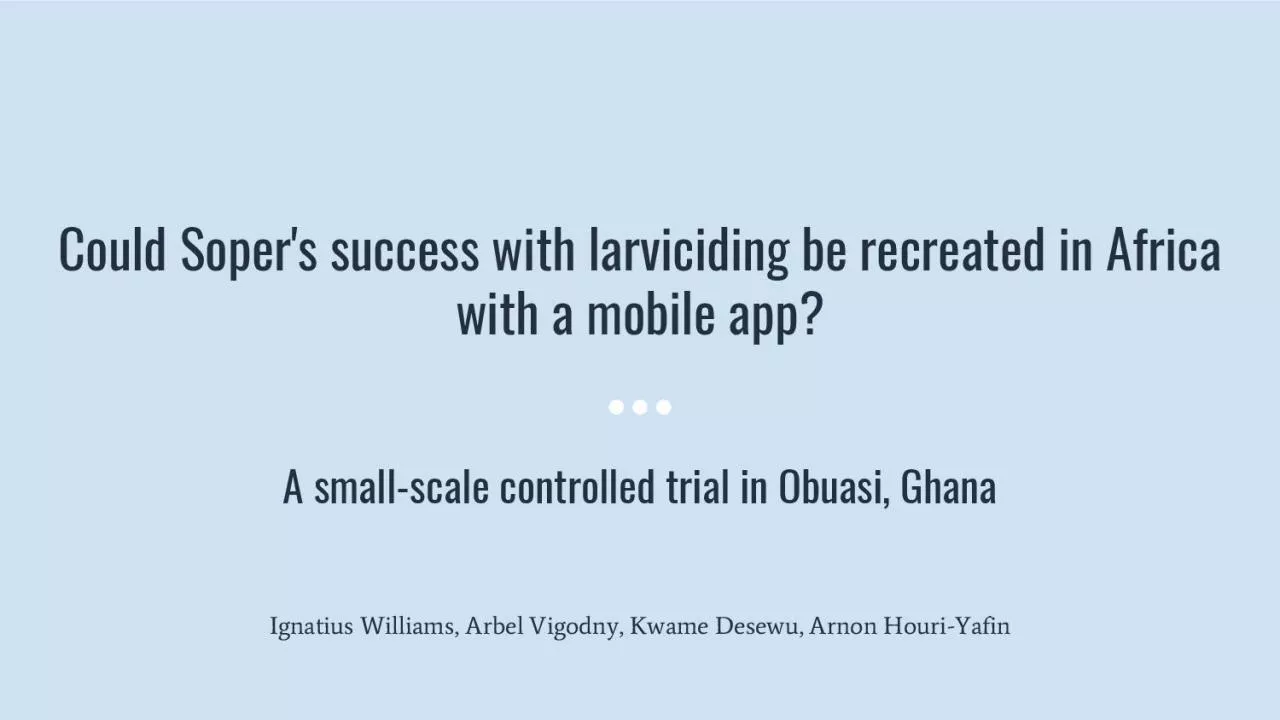

with a mobile app A small scale controlled trial in Obuasi Ghana Ignatius Williams Arbel Vigodny Kwame Desewu Arnon Houri Yafin Background 1938 1940 campaign to eliminate Anopheles ID: 955584
Download Pdf The PPT/PDF document "Could Sopers success with larviciding be..." is the property of its rightful owner. Permission is granted to download and print the materials on this web site for personal, non-commercial use only, and to display it on your personal computer provided you do not modify the materials and that you retain all copyright notices contained in the materials. By downloading content from our website, you accept the terms of this agreement.
Could Soper's success with larviciding be recreated in Africa with a mobile app? A small - scale controlled trial in Obuasi, Ghana Ignatius Williams, Arbel Vigodny, Kwame Desewu, Arnon Houri - Yafin Background ❖ 1938 - 1940 : campaign to
eliminate Anopheles gambiae from eastern Brazil led by Fred Soper [ 1 ] ➢ Primary method: larviciding ➢ Success within 2 years ➢ Key challenges: worker management & high coverage ❖ 2019 : use of larviciding for vector control is marg
inal ❖ Control programs and policy makers focus on adulticiding [1] Killeen, G., Fillinger, U., Kiche, I., Gouagna, L. and Knols, B. (2002). Eradication of Anopheles gambiae from Brazil: le sso ns for malaria control in Africa?. The Lancet Infectio
us Diseases, 2(10), pp.618 - 627. Operational challenges in large - scale larviciding ❖ Low coverage of water sources (Only 66.2 % in Chaki et al. [ 2 ] ) ❖ Difficulty in returning to treated water sources for respraying ❖ Requires a stron
g surveillance system (WHO Operational Manual, 2013 ) ❖ Low cost - effectiveness in remote/rural areas (WHO position statement, 2012 ) [2] Chaki, P., Govella, N., Shoo, B., Hemed, A., Tanner, M., Fillinger, U. and Killeen, G. (2009). Achieving hi
gh coverage of la rval - stage mosquito surveillance: challenges for a community - based mosquito control programme in urban Dar es Salaam, Tanzania. Malaria Journal, 8(1 ). Zzapp System: tackles larviciding operational challenges ❖ Mobile app -
allocates tasks, guides field workers, collects and transmits data ❖ Executive web portal - displays data to campaign managers and alerts to undertreated areas Executive Web Portal: Planning and Costing Executive Web Portal: Surveillance
and Progress Zoom in: water source details, including larva presence if sampled Mobile app: scanning ❖ Allocates small chunks of land for field workers to scan. ❖ Tracks workers using GPS to ensure the entire chunk is covered. ❖ Route
is highlighted in yellow, making it clear where to scan next. ❖ Team leader approves or rejects the chunk based on the worker’s route Mobile app: Reporting and Spraying ❖ Potential larval sites are geotagged and presented on the map ❖ S
prayers revisit the sites at the required spraying frequency A randomized controlled trial in Obuasi, Ghana ❖ Mining town located in the Ashanti region ➢ 175,000 residents ❖ AGAMal - a malaria control company, subsidiary of the A
ngloGold Ashanti gold mine (see: www.agamal.org ) ➢ Successful IRS program ➢ Recently initiated larviciding Objective Does the mobile app increase larviciding coverage in a semi - urban setting? ❖ Experimental groups: ➢ Scanning wit
h the mobile app - experimental ➢ Routine scanning method (managed by a team leader) - control ❖ Outcome variable: number of water sources reported Method ❖ Participants: 10 spraying workers from AGAMal ➢ Randomly divided into
two groups ❖ Scanning area: 1 , 200 m x 600 m ❖ Procedure: ➢ Day 1 : group 1 area A, group 2 area B ➢ Day 2 : group 1 area B, group 2 area A A B Results Control group Mobile app group Total reports 147 87
Duplicate reports 75 5 Erroneous reports 2 0 Outside bounds 6 0 Total valid sites 64 82 Guided by the mobile app, workers detected 28% more water sources. Future studies ❖ Implementation in a large - scale larviciding op
eration ❖ Assess impact on Anopheles and malaria reduction ❖ Larviciding following case detection ❖ Spatial Intelligence System (SIS) ➢ Integration with drones and satellites ➢ To be tested soon in Zanzibar ➢ Funded by IVCC Than